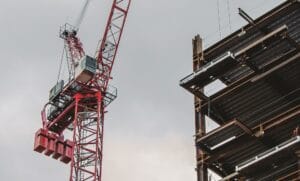It now costs about 20 percent more to build a commercial building in the United States than it did a year ago, according to an analysis of government data by a major construction trade group.
The Associated General Contractors of America analyzed data from the Bureau of Labor Statistics’ Producer Price Index to determine that the overall cost of a basket of materials commonly used in nonresidential construction jumped by 20.3 percent from January 2021 to January 2022. That increase includes a 2.6 percent increase from December 2021 to January 2022, alone.
“Unfortunately, there has been no letup early this year in the extreme cost runup that contractors endured in 2021,” AGC chief economist Ken Simonson said in a statement. “They are apparently passing on more of those costs but will have a continuing challenge in getting timely deliveries and finding enough workers.”
The Producer Price Index data covers several different commodities, many of which saw big jumps in money factories, distributors and trucking firms charge contractors over the last 12 months:
- Steel mill products up 112 percent
- Plastic construction products up 35 percent.
- Diesel fuel up 56.5 percent.
- Aluminum mill shapes up 32.7 percent.
- Copper and brass mill shapes up 24.8 percent over the year.
- “Architectural coatings” (includes paint) up 24.3 percent.
- Lumber and plywood up 21.1 percent.
- Insulation up 19.2 percent.
- Trucking up 18.3 percent
- Construction machinery and equipment up 11.4 percent.
Subcontractors’ prices are up for nonresidential work nation-wide, too. Concrete contractors’ prices are up 18.8 percent year-over-year in January, roofing contractors’ up 13.9 percent, electrical contractors’ up 11.4 percent and plumbing contractors up 9.9 percent.
One bright spot may be the price of concrete: A separate index reported by the Federal Reserve Bank of St. Louis that also uses Producer Price Index data shows the price of ready-mix concrete is only up 4.5 percent in the Northeast Census region, which covers New England, New York, New Jersey and Pennsylvania.
“Spiking materials prices are making it challenging for most firms to profit from any increases in demand for new construction projects,” AGC CEO Stephen E. Sandherr said in a statement. “Left unabated, these price increases will undermine the economic case for many development projects and limit the positive impacts of the new infrastructure bill.”
So far, though, AGC’s research shows contractors aren’t passing all these costs onto developers and other clients, although the gap between bid prices and input costs reported by AGC has narrowed significantly since summer 2021.







